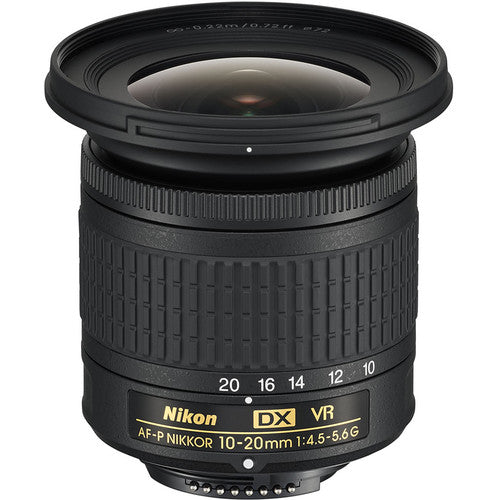Product Description
Nikon AF-P 10-20mm f4.5-5.6 G DX NIKKOR VR Lens F-Mount Lens/DX Format
- Maximum Aperture: f4.5-5.6
- Pulse Stepping Motor AF System
- VR Image Stabilization
- 72mm Filter thread
A versatile wide-angle zoom for Nikon DX-format DSLRs, the AF-P DX NIKKOR 10-20mm f4.5-5.6 G VR is a flexible lens offering a 15-30mm equivalent focal length range. Despite its wide field of view, Vibration Reduction (VR) image stabilization is featured to help minimize the appearance of camera shake for sharper handheld shooting. The lens also features a pulse stepping motor AF system, which benefits both video and photo applications due to its fast, quiet, and smooth focusing performance.

Flexible wide-angle zoom is designed for DX-format F-mount DSLRs where it provides a 15-30mm equivalent focal length range.
A pulse stepping motor AF system enables accurate and silent focusing that works well in both stills and video shooting.

Vibration Reduction image stabilization compensates for camera shake in order to deliver sharper handheld images.
| Focal length | 10–20 mm |
| Maximum aperture | f/4.5 to 5.6 |
|
Minimum aperture |
f/22 to 29 |
| Lens construction | 14 elements in 11 groups (including 3 aspherical lens elements) |
| Angle of view | 109° to 70° |
| Minimum focus distance | 0.22 m (0.8 ft) from focal plane at all zoom positions |
| Maximum reproduction ratio | 0.17x |
| Vibration reduction | Yes, 3.5 stops (When attached to a Nikon DX-format digital SLR camera with zoom, set at the maximum telephoto position. Based on CIPA Standard) |
| No. of diaphragm blades | 7 (rounded diaphragm opening) |
| Filter attachment size | 72 mm (P = 0.75 mm) |
| Diameter x length (extension from lens mount) | Approx. 77.0 mm maximum diameter x 73.0 mm (distance from camera lens mount flange) |
| Weight | Approx. 230 g (8.2 oz) |
| Supplied accessories | LC-72 72 mm snap-on Front Lens Cap, LF-4 Rear Lens Cap, HB-81 Bayonet Hood, CL-1015 Lens Case |























